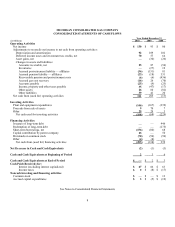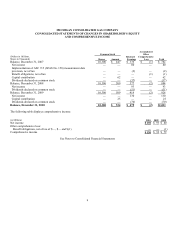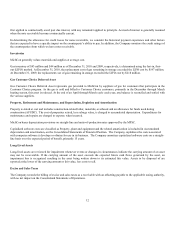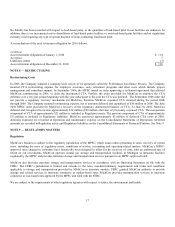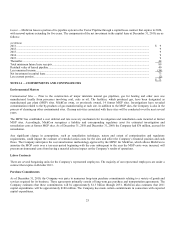DTE Energy 2010 Annual Report Download - page 17
Download and view the complete annual report
Please find page 17 of the 2010 DTE Energy annual report below. You can navigate through the pages in the report by either clicking on the pages listed below, or by using the keyword search tool below to find specific information within the annual report.
15
Investments hold money market debt securities through a publicly traded institutional mutual fund, valued using quoted market prices
in actively traded markets.
Fair Value of Financial Instruments
The fair value of long-term debt is determined by using quoted market prices when available and a discounted cash flow analysis
based upon estimated current borrowing rates when quoted market prices are not available. The table below shows the fair value and
the carrying value for long-term debt securities. Certain other financial instruments, such as notes payable, customer deposits and
notes receivable are not shown as carrying value approximates fair value.
December 31, 2010
December 31, 2009
Fair Value
Carrying Value
Fair Value
Carrying Value
Long-Term Debt
$981 million
$889 million
$942 million
$889 million
NOTE 5 — FINANCIAL AND OTHER DERIVATIVE INSTRUMENTS
The Company recognizes all derivatives at their fair value on the Consolidated Statements of Financial Position unless they qualify for
certain scope exceptions, including the normal purchases and normal sales exception. Further, derivatives that qualify and are
designated for hedge accounting are classified as either hedges of a forecasted transaction or the variability of cash flows to be
received or paid related to a recognized asset or liability (cash flow hedge), or as hedges of the fair value of a recognized asset or
liability or of an unrecognized firm commitment (fair value hedge). For cash flow hedges, the portion of the derivative gain or loss
that is effective in offsetting the change in the value of the underlying exposure is deferred in Accumulated other comprehensive
income and later reclassified into earnings when the underlying transaction occurs. For fair value hedges, changes in fair value for the
derivative are recognized in earnings each period. Gains and losses from the ineffective portion of any hedge are recognized in
earnings immediately. For derivatives that do not qualify or are not designated for hedge accounting, changes in the fair value are
recognized in earnings each period.
The Company’ s primary market risk exposure is associated with commodity prices, credit and interest rates. MichCon has risk
management policies to monitor and manage market risks.
Commodity Price Risk
The Company has fixed-priced contracts for portions of its expected gas supply requirements through March 2014. These gas supply
contracts are designated and qualify for the normal purchases and sales exemption and are therefore accounted for under the accrual
method. We may also sell forward storage and transportation capacity contracts. Forward firm storage and transportation contracts are
not derivatives and are therefore accounted for under the accrual method.
Credit Risk
The Company is exposed to credit risk if customers or counterparties do not comply with their contractual obligations. MichCon
maintains credit policies that significantly minimize overall credit risk. These policies include an evaluation of potential customers’
and counterparties’ financial condition, credit rating, collateral requirements or other credit enhancements such as letters of credit or
guarantees. The Company generally uses standardized agreements that allow the netting of positive and negative transactions
associated with a single counterparty.
The Company maintains a provision for credit losses based on factors surrounding the credit risk of its customers, historical trends,
and other information. Based on the Company’ s credit policies and its December 31, 2010 provision for credit losses, the Company’ s
exposure to counterparty nonperformance is not expected to have a material adverse effect on the Company’ s financial statements.





